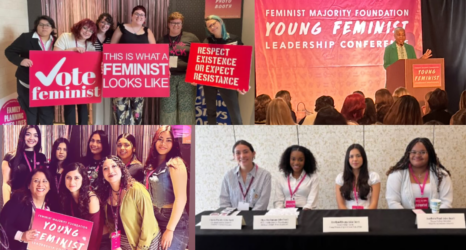This is the fourth in a multi-part series examining the half-century fight to add women to the U.S. Constitution—and a game plan on where we go from here.
Read Part 1: “We Want In!,” Part 2: A Long History of Obstruction, Delay and Trickery and Part 3: A Patchwork of Laws, Statutes and Court Rulings.
And check back every Wednesday for a new installment.
Part 4: From Addressing the Wage Gap to Combatting Violence Against Women, We Still Need an Equal Rights Amendment
“If our rights are in the Constitution, they can’t be erased or rolled back by the changing political whims of legislators, judges or occupants of the White House,” says Rep. Carolyn Maloney (D-N.Y.), a leading advocate for the ERA in Congress.
“Women’s equality will be spelled out in the Constitution. And we will spell it E-R-A.”
The ERA would give lawmakers the power to pass stronger laws to address sex discrimination and violence against women.
In 2000, the Supreme Court invalidated an important provision of the Violence Against Women Act that allowed survivors of gendered violence to sue their attackers for damages because it ruled that Congress had no constitutional authority to enact the provision.
According to Erwin Chemerinsky, dean of UC Berkeley School of Law, the ERA would “give Congress the authority to adopt laws to enforce equality. So [that provision of] the Violence Against Women Act would be more likely to be upheld under Congress’ power under the ERA.”
Constitutional law scholar and former dean of Stanford Law School Kathleen Sullivan adds, “The ERA clarifies that Congress has the power to enforce the amendment by enacting federal laws prohibiting sex discrimination that has gone unaddressed by the states—a new source of potentially powerful congressional authority against state lapses in protection against domestic violence, sexual assault and unequal employment practices.”
The ERA could also help address the wage gap. “The ERA would enable Congress to redress the systematic underenforcement of equal rights,” Sullivan says.

“For example, if women were being paid less than men for the same job, even in the private sector, and the states failed to do anything about that under existing state anti-discrimination laws, the ERA could give Congress the power to rectify state inaction to redress equality.”
To predict what impact the ERA could have, we can just look at how state-level ERAs have helped win concrete change to secure women’s rights. Twenty-five states have passed their own ERAs, and several more are taking steps to enshrine women’s equality in their state constitutions. One house of the state legislatures in New York, Maine and Minnesota have passed state-level ERAs last year.
State Rep. Lois Reckitt (D)—who was active in NOW’s 1970s ERA campaign (and was one of NOW’s leaders in the 1980s)—is heading the fight to pass the state ERA in Maine.

“It would give us the constitutional basis for equality, which would be much more secure than any of the minor pieces we have done,” Reckitt told Ms.
Only the ERA would establish “the permanence of equality,” Reckitt says. “I fear things like if the Affordable Care Act is overturned that gender discrimination in health insurance will return, because anything is reversible relatively easily unless it’s embedded in the Constitution.”
Many states have interpreted their ERAs to provide stronger protections than the U.S. Supreme Court has interpreted the 14th Amendment’s Equal Protection Clause to provide.
A majority of the state ERAs, for example, apply “strict scrutiny” to gender-based classifications in the law—a higher standard than currently applied at the federal level. That means that the government must prove that gender-based classifications are necessary to achieve a compelling government interest and they must be narrowly tailored to achieve that interest—a standard met only in exceptional circumstances like affirmative action.
Some states apply an even stricter standard. Pennsylvania and Washington use an “absolute standard” under their ERAs, meaning that any gender-based classifications are presumed to be unconstitutional.
And unlike the federal Equal Protection Clause, many state ERAs have invalidated so-called facially neutral laws that have a disproportionately negative impact on women and people of color, and laws based on biological differences like pregnancy.
In addition, while the 14th Amendment only protects against discriminatory action by governments and state actors, many state ERAs prohibit sex discrimination by private entities as well.
The success of state ERAs in eliminating discriminatory laws is strong proof that a federal ERA will have real-world impact and make women’s lives better.
Keep reading:
This piece is excerpted from the Spring 2020 issue of Ms.
Become a Ms. member to read the rest—and get even more of our feminist reporting and analysis delivered to your door, or to your mobile device, each time we release a new issue!





